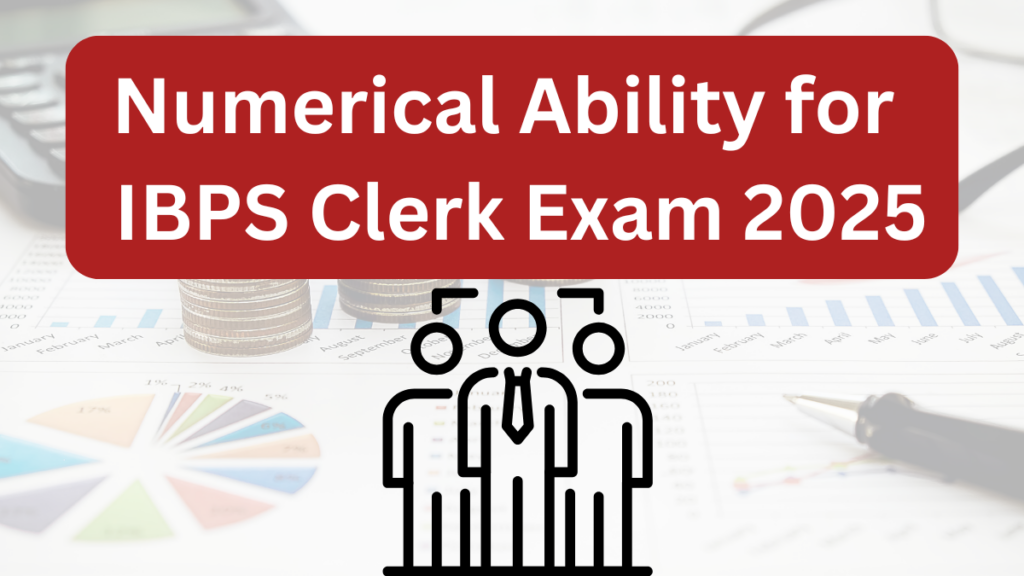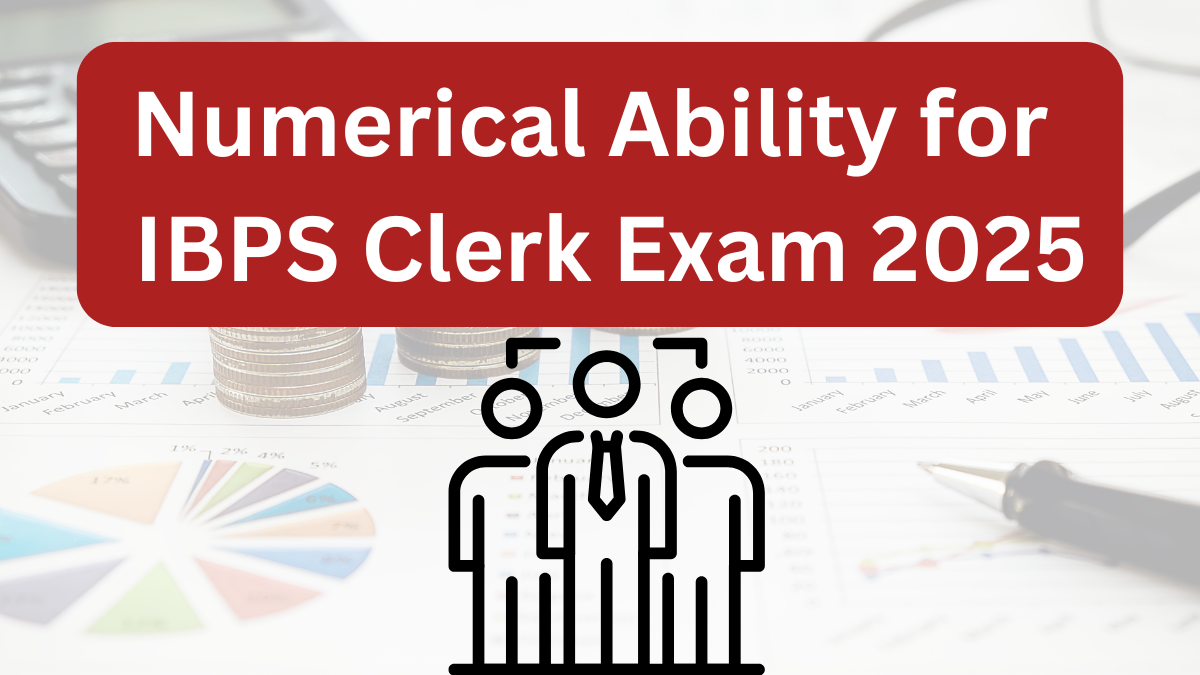The Numerical Ability section in the IBPS Clerk Exam is widely acknowledged as one of the most challenging areas of the exam. For many candidates, this section can seem daunting, but with the right strategy and preparation, achieving a high score is entirely within reach. This section includes a diverse range of topics—from fundamental arithmetic to more advanced concepts such as ratios, interest calculations, probability, and much more. By focusing on each topic, mastering the key concepts, and practicing regularly, you can significantly improve your score and your chances of passing the exam.
In this article, we’ll dive deep into the important topics, effective strategies, and tips for acing the Numerical Ability section of the IBPS Clerk Exam 2025.

IBPS Clerk Quantitative Aptitude Syllabus Breakdown
The key to mastering the Numerical Ability section lies in understanding the syllabus thoroughly. This section is part of both the IBPS Clerk Preliminary and Mains exams, and having a strong grasp of the essential mathematical concepts can dramatically improve your performance. Here’s an expanded breakdown of the topics covered in the Quantitative Aptitude section:
| Key Topics | Description |
|---|---|
| Time and Work | Learn how to calculate the time taken by individuals or groups to complete a task based on their work rate. Includes joint work problems. |
| Ratio and Proportion | Questions dealing with the relationship between two quantities, including solving for unknowns in a given ratio. |
| Logarithms | Focus on the fundamental principles of logarithms, solving equations involving logarithmic and exponential functions. |
| Distance and Time | Involves calculating speed, time, and distance, including relative speed problems and their applications in real-life scenarios. |
| Data Interpretation | Problems that present data in tables, bar graphs, pie charts, or line graphs, require you to analyze and interpret the data to answer questions. |
| Mixture and Allegation | Solve problems related to mixtures of different quantities, such as mixing solutions or combining items at different prices. |
| Profit, Discount & Loss | Learn the concepts of profit, discount, and loss, including percentage-based calculations commonly seen in commercial transactions. |
| Partnership, Stocks & Shares | Understand how business partnerships work and the distribution of profits, as well as how to calculate profits in stock market investments. |
| Algebra Elements | Includes simplifying algebraic expressions, solving linear and quadratic equations, and working with variables and constants. |
| Surface Area and Volume | Solving problems related to the surface area and volume of various three-dimensional shapes such as cubes, cylinders, and spheres. |
| Mensuration | Involves understanding the measurement of length, area, and volume for different geometric shapes, both 2D and 3D. |
| Equations & Probability | Learn to solve algebraic equations, including linear and quadratic types, and understand basic concepts of probability. |
| Line & Pie Charts | Focus on interpreting and solving problems based on line and pie charts. You’ll need to extract information and make calculations from these graphs. |
| Simple/Compound Interest | Solve problems related to calculating interest on principal amounts, either simple or compound interest, and their applications. |
| Trigonometry | Understand the basics of angles, sine, cosine, tangent, and other trigonometric functions and their use in solving geometric problems. |
| Combinations & Permutations | Work on problems that involve calculating the number of ways to arrange or select items, focusing on permutations and combinations. |
| Speed and Clocks | Questions involving time-related problems, such as calculating the time taken to complete a task or determining clock angles. |
| Bar Graph, Graph & Tables | Work with data presented in graphical forms, including bar graphs, pie charts, and tables. You’ll need to extract data to answer questions. |
| Coded Inequalities | These questions test your ability to decode and solve inequality relationships that are coded in symbols. |
| Syllogism & Quadratic Equations | Involves logical reasoning through statements and conclusions, and solving quadratic equations. |
| Simplification & Puzzles | Simplifying mathematical expressions and solving logical puzzles that test your problem-solving skills. |
| Alphanumeric & Number Series | Work with number series and alphanumeric sequences, often involving pattern recognition and missing elements. |
Time Management Tips for IBPS Clerk Numerical Ability Section
The Numerical Ability section in the IBPS Clerk Mains exam is a high-stakes part of the test. It consists of 50 questions, each worth one mark, and is to be completed within a strict time limit of 45 minutes. With the pressure of time, candidates need to manage it wisely to maximize their chances of success. Here are some expert time management strategies:
-
Prioritize High-Scoring Questions: Start by focusing on the questions that you can answer the quickest and with the most accuracy. Typically, Data Interpretation, Simplifications, and Quadratic Equations tend to be faster to solve, so make these your starting points.
-
Aim for Speed and Accuracy: Try to complete each question within 35-40 seconds. Accuracy is crucial, as incorrect answers will lead to a deduction of marks (0.25 marks for each wrong answer).
-
Skip Complex Questions: If a question seems too time-consuming or complex, don’t waste time on it. Mark it for review and move on. You can always come back to it later if time permits.
-
Mock Tests and Practice: Regularly practice with mock tests and previous years’ papers. This not only helps with time management but also familiarizes you with the exam pattern and question types.
Effective Study Tips for IBPS Clerk Numerical Ability Section
Here are some key strategies to help you build a strong foundation in the Numerical Ability section:
1. Understand the Syllabus Thoroughly
-
First Step: Familiarize yourself with the entire syllabus. Identify the topics that carry more weight and require deeper understanding and focus.
-
Create a Study Plan: Based on the syllabus, create a study schedule that dedicates specific time to each topic, ensuring that you cover all areas.
2. Practice Regularly
-
Consistent Practice: Practice regularly with mock tests and sample papers to develop speed and accuracy. The more problems you solve, the more you’ll understand how to approach different types of questions.
-
Review Mistakes: After completing practice tests, go over any mistakes made and understand why you got them wrong. This will help prevent similar errors in the actual exam.
3. Learn Shortcuts and Tricks
-
Time-Saving Techniques: Learn shortcuts for solving problems, particularly in areas like simplifications, number series, and percentages. These will help you save valuable time during the exam.
-
Use Online Resources: Take advantage of online classes or video tutorials to learn new techniques that can speed up your problem-solving process.
4. Utilize Study Materials
-
Books and Online Modules: Invest in good study materials specifically designed for the IBPS Clerk exam. Whether it’s books, online resources, or coaching classes, choose what suits your learning style.
5. Focus on Weak Areas
-
Target Weaknesses: Identify areas where you struggle the most and dedicate extra time to practicing those topics. Use targeted practice to improve your weak points.
Frequently Asked Questions (FAQs)
Q1: How many questions are there in the Numerical Ability section of the IBPS Clerk Exam?
-
There are 50 questions in the Numerical Ability section of the IBPS Clerk Exam, each carrying one mark.
Q2: What is the time limit for the IBPS Clerk Numerical Ability section?
-
The time limit for this section is 45 minutes.
Q3: Is there a negative marking for incorrect answers in the IBPS Clerk Exam?
-
Yes, there is a negative marking. For every incorrect answer, 0.25 marks are deducted.
Q4: How can I improve my speed in solving numerical problems?
-
Regular practice, learning shortcuts, and focusing on solving simpler questions first can greatly improve your speed and accuracy in solving numerical problems.
By following the tips mentioned above and dedicating yourself to consistent practice and improvement, you’ll be better equipped to excel in the Numerical Ability section of the IBPS Clerk Exam 2025. Stay focused, work smartly, and manage your time effectively to maximize your chances of success.
Click here to learn more
Sachin is a dedicated writer specializing in education, career, and recruitment topics, delivering clear and actionable insights to empower readers.
